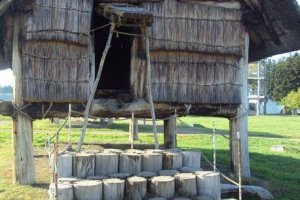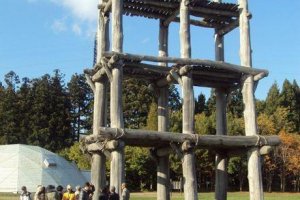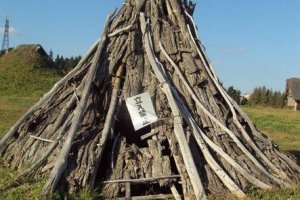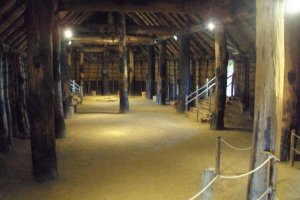Japan is full of history. The outside world tends to focus on WWII or the samurai era, but history goes back, way back, at Sannai-Maruyama. This Jōmon historical and archeological site in Aomori dates back 5000 years. The Jōmon period, which took place from 14,000 BC to 300 BC, is distinguished by its cord-imprinted pottery. It was the Stone Age. Agriculture was still in its infancy. When you visit, you can see how the inhabitants of Sannai-Maruyama struggled to survive. What you’ll also see, however, is that Jōmon society was incredibly advanced and sophisticated for their time. Dwellings, pottery, tools, graves, and even remains of roads prove that modern society may not have come as far as we once thought.
Sannai-Maruyama is huge. Most museums or buildings in Japan are on the small side to save on rent and space, so be prepared to do some walking. The main building houses a museum, gift shop, restaurant, library, and area to make your own Jōmon art projects. As I step into the Sannai-Maruyama main hall, I am greeted in English with a warm smile. My smile turns into a grin when the friendly staff tells me that admission to the facilities is free of charge. My first stop is watching a video in the theater about Jōmon history and the site itself. The movie is in Japanese, yet anyone can appreciate the previews of what you’ll soon experience. I am very excited about history, so I couldn’t wait anymore. I stepped out of the movie halfway through to see the main attraction outside.
Turn left from the main hallway and you are walking through time. The rocky walls and the ceiling create a feeling that you are scurrying through an underground tunnel dug out by archeologists. The light at the end becomes brighter and brighter until…nothing. I step outside and I see a wide open area, but there is nothing there. I told you this place is big. You need to walk about a quarter mile left to reach the village.
Then the magic finally happens. I stroll by houses that are half buried in the ground. A hole in the roof is where smoke from a fire inside would drift out. Since the house is made of nothing more than sticks, you could feel shivers run through your body if you imagine what these people must have went through when it rained or snowed. Further down the walking path is a long meeting hall. Keep in mind these buildings are reconstructions that were made using techniques and materials the Jōmon would have had access to. The large hall was used for village gatherings. It could easily house over a hundred people and is a great escape from the summer heat I took advantage of. Exit the far end of the structure and there is a dominating tower staring down at you. It looks like a watchtower to me, but in reality it is probably a type of raised storage or living area. And then there are these strange modern dome buildings.
Inside these metal and concrete bubbles is the real history. The Sannai-Maruyama site is also an active archeological site. Within several of these dome buildings are remains of village foundations or original stones and pit areas. At the far end of the park inside a building that houses a restroom is also a small room filled with laboring workers. Through a barely visible window you can peek at people reassembling pieces of pottery that have been found at that very site. Your last stop before you leave is the amazing museum on the premises back in the main hall.
Again more free admission has me running around with joy to explore the museum. Stone tools are amazingly shaped and sharp. The next room has ancient fishing hooks and figures of people wearing period clothing hunting or performing daily tasks. There is even an area (again free!) where you could try on your own period clothing and take some souvenir pictures. Right before you exit, a mountain of reassembled Jōmon pottery towers above other exhibits. Look closer and you could see that cord or rope was pushed into and removed from the pottery to create the stunning designs.
From Aomori station, the Sannai-Maruyama site is a 20 minute bus ride away. It’s an amazing place for anyone interested in early Japanese history and the free attractions mean you won’t be breaking the bank to enjoy it. With the encouragement of friendly staff and numerous facilities, you could easily spend two hours viewing and relaxing at Aomori City’s history central.
For more Jomon-era fun, check out the stone circles of Oyu down the road in Akita.











![[2013夏‧東北四祭] 萱野高原 [2013夏‧東北四祭] 萱野高原](https://a2.cdn.japantravel.com/photo/6676-47256/90x60!/青森-2013夏-東北四祭-萱野高原-47256.jpg)


















